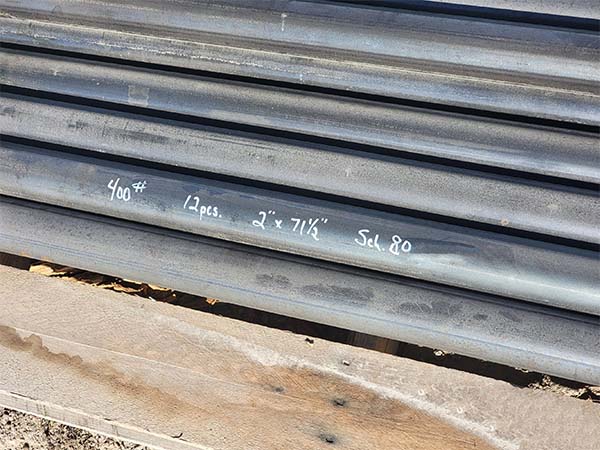
The following takes ASTM A53 carbon steel pipe as an example and lists some size data for intuitive comparison.
|
Nominal diameter NPS |
Outer diameter (inches) |
Sch 40 Wall thickness (inches) |
Sch 80 Wall thickness (inches) |
Sch 40 weight (lb/ft) |
Sch 80 weight (lb/ft) |
Sch 40 pressure rating (psi) * |
Sch 80 pressure rating (psi) * |
|
1" |
1.315 |
0.133 |
0.179 |
1.68 |
2.17 |
~450 |
~630 |
|
2" |
2.375 |
0.154 |
0.218 |
2.64 |
3.66 |
~400 |
~575 |
|
3" |
3.500 |
0.216 |
0.300 |
5.80 |
7.58 |
~370 |
~550 |
|
4" |
4.500 |
0.237 |
0.337 |
7.29 |
10.79 |
~350 |
~530 |
*The pressure rating is an approximate value and actually depends on the material grade and the operating temperature.
It can be seen from the table that under the same outer diameter, the wall thickness and weight of Schedule 80 are significantly higher than those of Schedule 40, which means it can withstand higher working pressure.
3. Core Difference Analysis
Wall thickness and strength
Schedule 80 has a thicker wall and higher strength, making it suitable for high-pressure applications.
Schedule 40 has a thinner wall thickness and is more suitable for low-pressure and structural applications.
Pressure resistance capacity
Increasing the wall thickness directly enhances the pressure resistance performance, making Schedule 80 safer in the transportation of high-pressure liquids or gases.
Weight difference
Schedule 80 is significantly heavier per foot and has higher transportation and installation costs.
Price difference
The price of Schedule 80 is higher than that of Schedule 40 because more steel is used.
4. Application scenario comparison
Schedule 40 Common Applications:
Urban water supply and drainage systems
Low-pressure air compressor pipeline
Building fences, scaffolding, and support frames
Agricultural irrigation system
Schedule 80 Common Applications:
Corrosive media and high-pressure pipelines in chemical plants
High-temperature and high-pressure steam system
Marine engineering, offshore platforms
Long-distance pipelines for oil and gas
High-pressure hydraulic system
5. Installation and operation precautions
Cutting and processing
Due to the large wall thickness, Schedule 80 takes longer to process and requires cutting equipment with greater power.
Thread processing and welding
When welding thick-walled pipes, higher current and longer welding time are required, and overheating should be avoided to prevent affecting the material performance.
Pipe support
It is heavier and requires denser and more secure pipe support points.
Anti-corrosion treatment
For long-term outdoor or damp environments, it is recommended to choose galvanized or stainless steel materials.
6. Cost factors
Material cost: Schedule 80 has a higher cost per foot.
Transportation and installation costs: An increase in weight will lead to higher transportation costs and labor costs.
Service life: Schedule 80 has a longer service life under high-pressure conditions, reducing long-term replacement costs.
Read more:SCH 40/80 pipe sizes